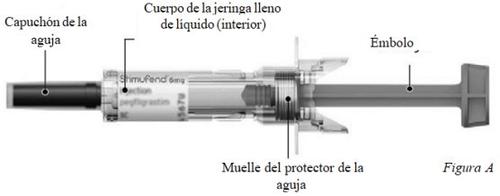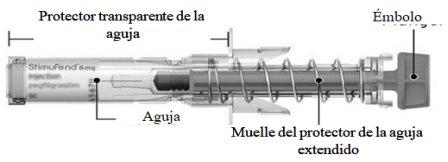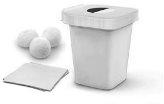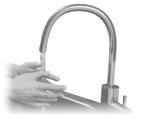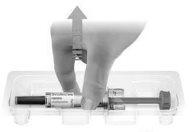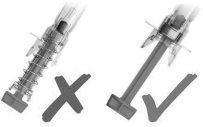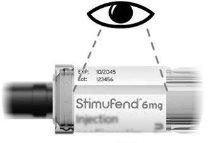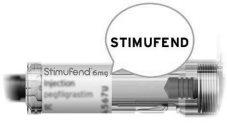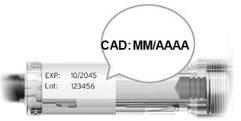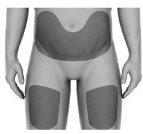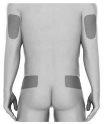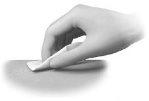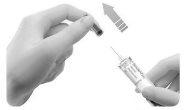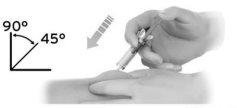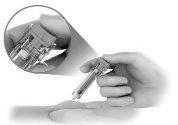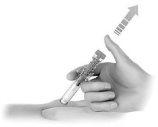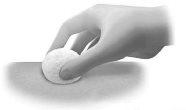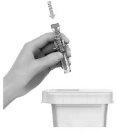
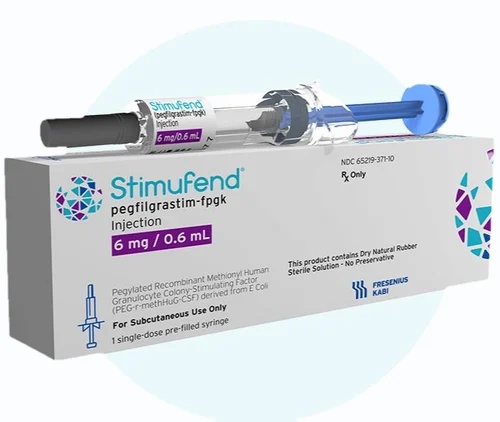
STIMUFEND 6 mg INJECTABLE SOLUTION IN PRE-FILLED SYRINGE


How to use STIMUFEND 6 mg INJECTABLE SOLUTION IN PRE-FILLED SYRINGE
Introduction
Package Leaflet: Information for the User
Stimufend 6 mg solution for injection in pre-filled syringe
pegfilgrastim
This medicinal product is subject to additional monitoring, which will allow for the quick identification of new safety information. You can help by reporting any side effects you may get. The last section of the leaflet contains information on how to report side effects.
Read all of this leaflet carefully before you start using this medicine, because it contains important information for you.
- Keep this leaflet, you may need to read it again.
- If you have any further questions, ask your doctor, pharmacist, or nurse.
- This medicine has been prescribed for you only. Do not pass it on to others. It may harm them, even if their signs of illness are the same as yours.
- If you get any side effects, talk to your doctor, pharmacist, or nurse. This includes any possible side effects not listed in this leaflet. See section 4.
Contents of the pack:
- What is Stimufend and what is it used for
- What you need to know before you use Stimufend
- How to use Stimufend
- Possible side effects
- Storing Stimufend
- Contents of the pack and other information
1. What is Stimufend and what is it used for
Stimufend contains the active substance pegfilgrastim. Pegfilgrastim is a protein produced by biotechnology in the bacterium E. coli. Pegfilgrastim belongs to a group of proteins called cytokines and is very similar to a natural protein (granulocyte-colony stimulating factor) produced by the body.
Stimufend is used to reduce the duration of neutropenia (low white blood cell count) and the incidence of febrile neutropenia (low white blood cell count and fever) that can occur as a result of cytotoxic chemotherapy (medicines that destroy rapidly dividing cells). White blood cells are important cells that help fight infections. These cells are sensitive to the effects of chemotherapy, which can cause their numbers to decrease. If the number of white blood cells becomes too low, there may not be enough to fight off bacteria, which can lead to an increased risk of infection.
Your doctor has prescribed Stimufend to stimulate your bone marrow (the part of the bone where blood cells are produced) to produce more white blood cells to help fight infections.
2. What you need to know before you use Stimufend
Do not use Stimufend
- if you are allergic to pegfilgrastim, filgrastim, or any of the other ingredients of this medicine (listed in section 6).
Warnings and precautions
Talk to your doctor, pharmacist, or nurse before starting Stimufend:
- if you experience an allergic reaction that includes weakness, low blood pressure, difficulty breathing, swelling of the face (anaphylaxis), redness and flushing, skin rash, and itching.
- if you are allergic to latex. The needle cap of the pre-filled syringe contains a latex derivative and may cause severe allergic reactions.
- if you are allergic to acrylic adhesives. The on-body injector uses an acrylic adhesive that may cause allergic reactions.
- if you experience cough, fever, and difficulty breathing. This may be a sign of Acute Respiratory Distress Syndrome (ARDS).
- if you experience any of the following side effects:
- swelling that may be associated with decreased urine output, difficulty breathing, swelling, and a feeling of fullness in the abdomen, and a general feeling of tiredness.
These may be symptoms of a rare condition called "Capillary Leak Syndrome" and may cause blood to leak from small blood vessels into other parts of the body. See section 4.
- if you have pain in the upper left abdomen or pain in the tip of the shoulder. This may be a sign of a problem with the spleen (splenomegaly).
- if you have recently had a severe lung infection (pneumonia), fluid in the lungs (pulmonary edema), inflammation of the lungs (interstitial lung disease), or an abnormal chest X-ray (pulmonary infiltrate).
- if you are aware of any changes in your blood cell count (e.g., increased white blood cell count or anemia) or a decrease in platelet count, which can reduce the ability of the blood to clot (thrombocytopenia). Your doctor may want to monitor you more closely.
- if you have sickle cell anemia. Your doctor may monitor your condition more closely.
- if you are a cancer patient, the combined treatment of Stimufend with chemotherapy and/or radiotherapy may increase the risk of developing a pre-cancerous blood disorder called myelodysplastic syndrome (MDS) or a blood cancer called acute myeloid leukemia (AML). Symptoms may include tiredness, fever, easy bruising or bleeding.
- if you experience sudden signs of allergy, such as rash, itching, or hives on the skin, swelling of the face, lips, tongue, or other parts of the body, shortness of breath, wheezing, or difficulty breathing, these may be signs of a severe allergic reaction.
- if you experience symptoms of inflammation of the aorta (the large blood vessel that carries blood from the heart to the rest of the body), this has rarely been reported in cancer patients and healthy donors. Symptoms may include fever, abdominal pain, general malaise, back pain, and increased inflammatory markers. Inform your doctor if you experience these symptoms.
Your doctor will regularly perform blood and urine tests as Stimufend may damage the small filters inside the kidneys (glomerulonephritis).
With the use of pegfilgrastim, severe skin reactions (Stevens-Johnson syndrome) have been reported. Stop using pegfilgrastim and seek medical attention immediately if you notice any of the symptoms described in section 4.
You should discuss with your doctor the risk of developing blood cancer. If you develop or may develop blood cancer, you should not use Stimufend, unless your doctor advises you to.
Loss of response to pegfilgrastim
If you experience a loss of response or if the response to treatment with pegfilgrastim cannot be maintained, your doctor will investigate the causes, including whether you have developed antibodies that may neutralize the activity of pegfilgrastim.
Other medicines and Stimufend
Tell your doctor or pharmacist if you are using, have recently used, or might use any other medicines.
Pregnancy and breastfeeding
Ask your doctor or pharmacist for advice before taking any medicine. Stimufend has not been used in pregnant women. It is important that you inform your doctor if:
- you are pregnant;
- you think you may be pregnant; or
- you are planning to have a baby.
If you become pregnant during treatment with Stimufend, inform your doctor.
Unless your doctor advises you otherwise, you should stop breastfeeding if you use Stimufend.
Driving and using machines
Stimufend has no or negligible influence on the ability to drive and use machines.
Stimufend contains sorbitol (E420) and sodium acetate
This medicine contains 30 mg of sorbitol in each 6 mg dose, equivalent to 50 mg/ml. This medicine contains less than 1 mmol of sodium (23 mg) per 6 mg dose; this is essentially "sodium-free".
3. How to use Stimufend
Stimufend is indicated in patients over 18 years of age.
Follow exactly the instructions for administration of this medicine given by your doctor.
Ask your doctor or pharmacist if you have any questions. The recommended dose is a single subcutaneous injection of 6 mg (under the skin), using a pre-filled syringe, and should be administered at the end of each chemotherapy cycle, at least 24 hours after the last dose of chemotherapy.
Self-injection of Stimufend
Your doctor may consider it more convenient for you to inject Stimufend yourself. Your doctor or nurse will teach you how to do it. Do not attempt to do it unless you have been taught.
For further instructions on how to self-inject Stimufend, read section 6 at the end of this leaflet.
Do not shake Stimufend vigorously as this may affect its activity.
If you use more Stimufend than you should
If you use more Stimufend than you should, inform your doctor, pharmacist, or nurse.
If you forget to use Stimufend
If you are self-injecting and have forgotten to administer your dose of Stimufend, contact your doctor to decide when you should inject the next dose.
If you have any further questions on the use of this medicine, ask your doctor, pharmacist, or nurse.
4. Possible side effects
Like all medicines, this medicine can cause side effects, although not everybody gets them.
Inform your doctor immediately if you experience any of the following side effects:
- swelling that may be associated with decreased urine output, difficulty breathing, swelling, and a feeling of fullness in the abdomen, and a general feeling of tiredness. These symptoms usually develop very quickly.
These may be symptoms of a rare condition called "Capillary Leak Syndrome" and may cause blood to leak from small blood vessels into other parts of the body and may require urgent medical attention.
Very common side effects(may affect more than 1 in 10 people):
- bone pain. Your doctor will inform you about what you can take to relieve the pain.
- nausea and headache.
Common side effects(may affect up to 1 in 10 people):
- injection site pain.
- general pain and pain in the joints and muscles.
- some changes in your blood may occur, which will be detected by regular blood tests. The number of white blood cells may increase for a short period. The number of platelets may decrease, which can cause bruising.
Uncommon side effects(may affect up to 1 in 100 people):
- allergic reactions, including redness and flushing, rash, and itching.
- severe allergic reactions, including anaphylaxis (weakness, low blood pressure, difficulty breathing, facial swelling).
- enlargement of the spleen.
- rupture of the spleen. Some cases of splenic rupture were fatal. It is important that you contact your doctor immediately if you notice pain in the upper left abdomen or left shoulder tip, as these may be related to a problem with your spleen.
- respiratory problems. If you have a cough, fever, and difficulty breathing, consult your doctor.
- cases of Sweet's syndrome (painful, inflamed, purple-colored lesions on the limbs and sometimes on the face and neck, accompanied by fever) have been reported, but may be related to other factors.
- cutaneous vasculitis (inflammation of the blood vessels in the skin).
- damage to the small filters inside the kidneys (glomerulonephritis).
- redness at the injection site.
- bleeding from the lungs (hemoptysis).
- blood disorders (myelodysplastic syndrome [MDS] or acute myeloid leukemia [AML]).
Rare side effects(may affect up to 1 in 1,000 people):
- inflammation of the aorta (the blood vessel that carries blood from the heart to the rest of the body), see section 2.
- bleeding from the lungs (pulmonary hemorrhage).
- Stevens-Johnson syndrome, which may appear as red, circular, or concentric patches, often with central blisters, on the trunk, exfoliation, ulcers in the mouth, throat, nose, genitals, and eyes; and may be preceded by fever and flu-like symptoms. Stop using Stimufend if you develop these symptoms and contact your doctor or seek medical attention immediately. See section 2.
Reporting of side effects
If you experience any side effects, talk to your doctor, pharmacist, or nurse, even if they are not listed in this leaflet. You can also report side effects directly via the national reporting system listed in Appendix V. By reporting side effects, you can help provide more information on the safety of this medicine.
5. Storing Stimufend
Keep this medicine out of the sight and reach of children.
Do not use this medicine after the expiry date which is stated on the carton and on the label of the pre-filled syringe after EXP. The expiry date is the last day of the month shown.
Store in a refrigerator (2°C - 8°C).
Stimufend may be exposed to room temperature (up to 30°C) for a maximum of 72 hours. If Stimufend has been exposed to room temperature for more than 72 hours, it should be discarded. For questions related to storage, consult your doctor, nurse, or pharmacist.
Do not freeze.
Keep the pre-filled syringe in the outer carton to protect it from light.
Do not use this medicine if you notice that the solution is not entirely clear or contains particles.
Medicines should not be disposed of via wastewater or household waste. Ask your pharmacist how to dispose of medicines no longer required. These measures will help protect the environment.
6. Contents of the pack and additional information
Composition of Stimufend
- The active substance is pegfilgrastim. Each pre-filled syringe contains 6 mg of pegfilgrastim in 0.6 ml of solution.
- The other ingredients are sodium acetate, sorbitol (E420), polysorbate 20, glacial acetic acid, and water for injectable preparations. See section 2 'Stimufend contains sorbitol (E420) and sodium acetate'.
Appearance of Stimufend and pack contents
Stimufend is a clear, colorless injectable solution in a pre-filled syringe (6 mg/0.6 ml).
Each pack contains 1 pre-filled glass syringe with a stainless steel needle and a needle cap.
The pre-filled syringe is supplied with an automatic needle guard.
Marketing authorisation holder
Fresenius Kabi Deutschland GmbH
Else-Kroener Strasse 1
61352 Bad Homburg v.d.Hoehe
Germany
Manufacturer
Fresenius Kabi Austria GmbH
Hafnerstrasse 36
8055 Graz
Austria
Date of last revision of this leaflet:
Other sources of information
Detailed information on this medicine is available on the European Medicines Agency website http://www.ema.europa.eu/.
Instructions for use of Stimufend (pegfilgrastim)
Single-dose pre-filled syringe for subcutaneous injection
Important:
Read the leaflet to understand the important information you need to know before using these instructions for use.
Before using a Stimufend pre-filled syringe, read this important information.
Storage of Stimufend pre-filled syringes:
- Store Stimufend in the refrigerator between 2°C and 8°C.
- Do notfreeze.
- Keep the pre-filled syringe in the original carton to protect it from light.
- Discard any Stimufend that has been left at room temperature, not above 30°C, for more than 72 hours.
- Keep the Stimufend pre-filled syringe out of the reach of children.
Using the pre-filled syringe:
- It is important that you do not attempt to inject Stimufend unless you or your caregiver have been trained by your healthcare professional.
- Do notinject Stimufend into children.
- A dose less than 6 mg/0.6 ml cannot be accurately measured with the Stimufend pre-filled syringe.
- Do notuse a pre-filled syringe after the expiration date on the label, as it may cause illness.
- Do notshake the pre-filled syringe.
- Do notremove the needle cap from the pre-filled syringe until you are ready to inject.
- Do notuse the pre-filled syringe if the carton is open or damaged.
- Do notuse the pre-filled syringe if it has been dropped onto a hard surface. The pre-filled syringe may be broken even if you do not see the break. Use a new pre-filled syringe.
- Do notuse Stimufend that has been frozen or exposed to direct sunlight.
- The needle cap of the pre-filled syringe contains dry natural rubber (latex). Inform your healthcare professional if you are allergic to latex. You should not administer Stimufend with the pre-filled syringe if you are allergic to latex.
- The Stimufend pre-filled syringe has a transparent needle guard that covers the needle after injection.
- Do notattempt to activate the transparent needle guard before injecting.
- Do notput your fingers into the opening of the transparent needle guard because the needle could hurt you.
- Do notattempt to reuse the Stimufend pre-filled syringe because it could cause infection.
Call your healthcare professional if you have any questions.
1.1 Prepare your materials |
Before injection
|
After injection(transparent needle guard locked)
Figure B |
1.1 Prepare your materials | |
| |
|
Figure C |
| |
| |
| |
|
Figure D |
| |
| |
Step 2: Wash your hands | |
2.1 Wash your hands | |
|
Figure E |
Step 3: Check your syringe | |
3.1 Remove the pre-filled syringe from the sealed plastic tray | |
| |
Do notgrab the pre-filled syringe by the plunger or the needle cap. If you do, you could damage the syringe or activate the transparent needle guard. |
Figure F |
3.2 Check your syringe | |
|
Figure G |
|
Figure H |
|
Figure I |
Do notuse the pre-filled syringe if it shows any signs of damage. If it does, discard the syringe in the container for disposing of sharp objects (see step 6) and contact your healthcare professional or pharmacist immediately. | |
3.3 Check the liquid | |
Check the liquid through the transparent window of the label to ensure that the medication is clear, colorless, and free of particles or flakes (Figure J). |
Figure J |
Do notuse the pre-filled syringe if the medication is cloudy or colored or if it has particles or flakes. If it does, discard the syringe in the container for disposing of sharp objects (see step 6) and call your healthcare professional or pharmacist immediately. | |
3.4 Check the label | |
Check the label on the syringe to ensure that: | |
|
Figure K |
Do notuse the pre-filled syringe if:
|
Figure L |
If it does, discard the syringe in the container for disposing of sharp objects (see step 6) and call your healthcare professional or pharmacist immediately. | |
Step 4: Prepare the injection | |
4.1 Choose the injection site (Figure M) | |
You can use:
|
Figure M |
|
Figure N |
Do notinject into an area that is painful (sensitive), bruised, red, hard, scarred, or has stretch marks or tattoos. | |
Do notinject through clothing. | |
4.2 Clean the injection site | |
Clean the skin at the injection site with an alcohol swab (Figure O). Let the skin dry. Do nottouch the injection site again before injecting. |
Figure O |
Step 5: Inject the medicine | |
5.1 Remove the needle cap | |
|
Figure P |
Do nottouch the needle or let it touch any surface after removing the needle cap. | |
5.2 Pinch the skin | |
|
Figure Q |
5.3 Insert the needle | |
|
Figure R |
5.4 Inject | |
|
Figure S |
|
Figure T |
Do notremove the needle from the skin when the plunger reaches the end. | |
5.5 Finish the injection | |
|
Figure U |
Important:Call your healthcare professional or pharmacist immediately if: the full dose is not injected or the transparent needle guard does not activate after a complete injection. Injecting an incorrect amount of medication could affect or delay your treatment. | |
Do notreuse the syringe in case of partial injection. | |
Do notattempt to recap the needle, as it could cause a needlestick injury. | |
|
Figure V |
Do notrub the injection site. | |
Step 6: Dispose of the pre-filled syringe | |
6.1 Placeused pre-filled syringes in a container for disposing of sharp objects immediately after use (Figure W). Do notthrow (discard) pre-filled syringes in household trash. |
Figure W |
| |
| |
Do notthrow the used container for disposing of sharp objects in household trash, unless your community guidelines allow it. | |
Do notrecycle the used container for disposing of sharp objects. |
- Country of registration
- Active substance
- Prescription requiredYes
- Manufacturer
- CompositionSORBITOL (30 mg mg), ACETATO DE SODIO TRIHIDRATO (0,12 mg mg), POLISORBATO 20 (0,02 mg mg)
- This information is for reference only and does not constitute medical advice. Always consult a licensed doctor before taking any medication. Oladoctor is not responsible for medical decisions based on this content.
- Alternatives to STIMUFEND 6 mg INJECTABLE SOLUTION IN PRE-FILLED SYRINGEDosage form: INJECTABLE, 6 mgActive substance: pegfilgrastimManufacturer: Biosimilar Collaborations Ireland LimitedPrescription requiredDosage form: INJECTABLE, 6 mg of pegfilgrastim (10mg/ml)Active substance: pegfilgrastimManufacturer: Amgen Europe B.V.Prescription requiredDosage form: INJECTABLE, 6 mgActive substance: pegfilgrastimManufacturer: Amgen Europe B.V.Prescription required


